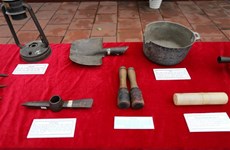Hanoi – Great tradition, bright future
In the 59 years since the liberation of Hanoi (October 10, 1954), the
city has taken on an entirely new look. With the motto "effective,
active and creative", city authorities have led Hanoi to overcome
challenges, maintain the economic growth rate and ensure social welfare.
Report by Nhan Dan Online newspaper.
In the 59 years since the liberation of Hanoi (October 10, 1954), the
city has taken on an entirely new look. With the motto "effective,
active and creative", city authorities have led Hanoi to overcome
challenges, maintain the economic growth rate and ensure social welfare.
Report by Nhan Dan Online newspaper.
Maintaining economic growth rate
Early this year, city leaders designated removing barriers to production and business activities as one of its key tasks in 2013, responding to the global economic crisis.
A municipal Steering Committee for resolving difficulties encountered by enterprises was established, holding extensive meetings with enterprises to hear their problems and recommendations. Through such meetings, many issues related to administrative procedures, taxes, banking loans, inventory and employment have been addressed thanks to actions taken by city authorities.
Thanks to the joint efforts of Hanoi’s authorities and its business community, the city's economy grew by 7.88 percent, year on year, in the first nine months of 2013. That figure is expected to rise to 8.1-8.2 percent for the entire year, meeting the annual target. Notably, the city's industrial production index has increased 4.4 percent compared to the same nine-month period in 2012.
Various commodities recorded increased export revenue in the first three quarters, including apparel, electronics and components, handicrafts and footwear. The apparel sector brought in the largest export revenue with 895 million USD, a 14.3 percent year-on-year increase. Hanoi’s aggregate foreign trade revenue went up by 23 percent against the same period last year.
The city contributed nearly 80 trillion VND (3.76 billion USD) to the State budget in the first eight months of this year, representing 16.5 percent of the nation's overall budget collection.
Vice Chairman of the Hanoi municipal People's Committee Nguyen Van Suu said that the figures resulted from considerable efforts made by the whole city, which have been very important for the development of enterprises, job creation, economic growth and State budget collection.
Tightening administrative discipline and improving competitiveness
Strengthening administrative reform with a focus on administrative procedure reform is one of two major tasks for socio-economic development in the 2010-2015 period laid out in the Resolution of the 15th Congress of Hanoi's Party Committee.
However, the work completed until now has yet to pay off, as Hanoi’s provincial competitiveness index has declined constantly. In 2012, Hanoi ranked 51st of the 63 provinces and cities in competitiveness, dropping 15 places from 2011.
To solve the problem, the city’s leaders have launched programmes to improve its competitiveness with the reform of administrative procedures considered as the key to eliminating red tape and inconveniences.
Such measures have created positive changes on the local level. Nearly all departments, sectors and districts have reviewed their working rules, promoted empowerment, implemented the ‘one-stop shop’ mechanism and enhanced the application of information technology in handling administrative procedures.
Some departments have come up with innovative and effective solutions. The Department of Justice, for example, has worked with the Municipal Police and the Department of Health to streamline administrative procedures so that a new-born baby can be granted a household registration and a health insurance card immediately. The Department of Internal Affairs is piloting the "one-stop shop" model at some State-owned enterprises and co-ordinating with other departments to reduce overlapping administrative procedures. Hai Ba Trung and Long Bien districts have been pioneers in reducing the number of meetings and enhancing the accountability of their leaders. The Department of Finance and Long Bien district have also been using CCTV cameras to monitor the attitude of civil servants towards the people.
In order to increase transparency in land use, the city government has ordered departments and local authorities to accelerate and publicise all information on land use planning in the 2011-2015 period. The city government has also scrapped some administrative procedures related to land and expedited the issuance of land use certificates. In addition, the city government has begun conducting frequent inspections to uncover and punish those who cause trouble for people and enterprises.
Although red tape has not been completely eliminated, the initial improvement in the awareness and responsibility of civil servants and officials is unmistakable. The most notable progress is that civil servants have now developed a greater awareness of their responsibility towards businesses and the people and.
Focusing resources on key infrastructure projects
2013 is the critical year in implementing the resolution of the 15th Municipal Party Congress, and departments and local authorities have been required to accelerate the construction of crucial infrastructure projects. However, it is worrying that 37 out of 55 key projects are behind schedule, according to the Department of Planning and Investment. The delay of these projects has been caused chiefly by lack of capital, bottlenecks in land clearance and weak management.
In order to tackle the shortage of capital, the city has issued bonds to raise 2 trillion VND (94 million USD) for five transport infrastructure projects, two hospitals and a water drainage project. The obstacles to land clearance have also been removed when the city has devised special mechanisms to pay appropriate compensation, support resettlement and increase dialogue with relocated households.
After two months of aggressive action, the hindrance to land clearance has basically been eliminated. Clear space is now available for the construction of Ring Road No.1, which is scheduled for completion by the end of the year. Work has also started on the Nga Tu So - Nga Tu Vong section of Ring Road No.2. The land clearance phases of some other projects, such as the new National Highway 3 and the road linking the Nhat Tan bridge and Noi Bai International Airport, are also nearing completion.
59 years after its liberation, Hanoi has transformed from a small and underdeveloped city into a large metropolis, especially since its administrative boundaries were expanded in 2008. Compared with 1954, the area of Hanoi has increased 18-fold, and its population is also 17 times larger. Despite a bumpy road ahead, it is believed that the Party committee and people of Hanoi will overcome all difficulties and challenges to make steady progress on the path to a wealthy, beautiful, civilised and modern capital city, worthy of the expectations and love of people around the nation.-VNA
Maintaining economic growth rate
Early this year, city leaders designated removing barriers to production and business activities as one of its key tasks in 2013, responding to the global economic crisis.
A municipal Steering Committee for resolving difficulties encountered by enterprises was established, holding extensive meetings with enterprises to hear their problems and recommendations. Through such meetings, many issues related to administrative procedures, taxes, banking loans, inventory and employment have been addressed thanks to actions taken by city authorities.
Thanks to the joint efforts of Hanoi’s authorities and its business community, the city's economy grew by 7.88 percent, year on year, in the first nine months of 2013. That figure is expected to rise to 8.1-8.2 percent for the entire year, meeting the annual target. Notably, the city's industrial production index has increased 4.4 percent compared to the same nine-month period in 2012.
Various commodities recorded increased export revenue in the first three quarters, including apparel, electronics and components, handicrafts and footwear. The apparel sector brought in the largest export revenue with 895 million USD, a 14.3 percent year-on-year increase. Hanoi’s aggregate foreign trade revenue went up by 23 percent against the same period last year.
The city contributed nearly 80 trillion VND (3.76 billion USD) to the State budget in the first eight months of this year, representing 16.5 percent of the nation's overall budget collection.
Vice Chairman of the Hanoi municipal People's Committee Nguyen Van Suu said that the figures resulted from considerable efforts made by the whole city, which have been very important for the development of enterprises, job creation, economic growth and State budget collection.
Tightening administrative discipline and improving competitiveness
Strengthening administrative reform with a focus on administrative procedure reform is one of two major tasks for socio-economic development in the 2010-2015 period laid out in the Resolution of the 15th Congress of Hanoi's Party Committee.
However, the work completed until now has yet to pay off, as Hanoi’s provincial competitiveness index has declined constantly. In 2012, Hanoi ranked 51st of the 63 provinces and cities in competitiveness, dropping 15 places from 2011.
To solve the problem, the city’s leaders have launched programmes to improve its competitiveness with the reform of administrative procedures considered as the key to eliminating red tape and inconveniences.
Such measures have created positive changes on the local level. Nearly all departments, sectors and districts have reviewed their working rules, promoted empowerment, implemented the ‘one-stop shop’ mechanism and enhanced the application of information technology in handling administrative procedures.
Some departments have come up with innovative and effective solutions. The Department of Justice, for example, has worked with the Municipal Police and the Department of Health to streamline administrative procedures so that a new-born baby can be granted a household registration and a health insurance card immediately. The Department of Internal Affairs is piloting the "one-stop shop" model at some State-owned enterprises and co-ordinating with other departments to reduce overlapping administrative procedures. Hai Ba Trung and Long Bien districts have been pioneers in reducing the number of meetings and enhancing the accountability of their leaders. The Department of Finance and Long Bien district have also been using CCTV cameras to monitor the attitude of civil servants towards the people.
In order to increase transparency in land use, the city government has ordered departments and local authorities to accelerate and publicise all information on land use planning in the 2011-2015 period. The city government has also scrapped some administrative procedures related to land and expedited the issuance of land use certificates. In addition, the city government has begun conducting frequent inspections to uncover and punish those who cause trouble for people and enterprises.
Although red tape has not been completely eliminated, the initial improvement in the awareness and responsibility of civil servants and officials is unmistakable. The most notable progress is that civil servants have now developed a greater awareness of their responsibility towards businesses and the people and.
Focusing resources on key infrastructure projects
2013 is the critical year in implementing the resolution of the 15th Municipal Party Congress, and departments and local authorities have been required to accelerate the construction of crucial infrastructure projects. However, it is worrying that 37 out of 55 key projects are behind schedule, according to the Department of Planning and Investment. The delay of these projects has been caused chiefly by lack of capital, bottlenecks in land clearance and weak management.
In order to tackle the shortage of capital, the city has issued bonds to raise 2 trillion VND (94 million USD) for five transport infrastructure projects, two hospitals and a water drainage project. The obstacles to land clearance have also been removed when the city has devised special mechanisms to pay appropriate compensation, support resettlement and increase dialogue with relocated households.
After two months of aggressive action, the hindrance to land clearance has basically been eliminated. Clear space is now available for the construction of Ring Road No.1, which is scheduled for completion by the end of the year. Work has also started on the Nga Tu So - Nga Tu Vong section of Ring Road No.2. The land clearance phases of some other projects, such as the new National Highway 3 and the road linking the Nhat Tan bridge and Noi Bai International Airport, are also nearing completion.
59 years after its liberation, Hanoi has transformed from a small and underdeveloped city into a large metropolis, especially since its administrative boundaries were expanded in 2008. Compared with 1954, the area of Hanoi has increased 18-fold, and its population is also 17 times larger. Despite a bumpy road ahead, it is believed that the Party committee and people of Hanoi will overcome all difficulties and challenges to make steady progress on the path to a wealthy, beautiful, civilised and modern capital city, worthy of the expectations and love of people around the nation.-VNA













